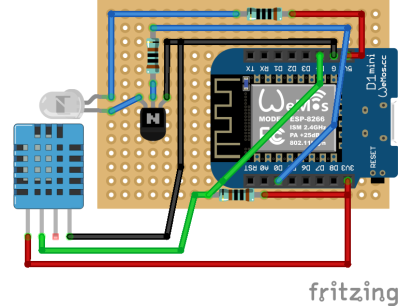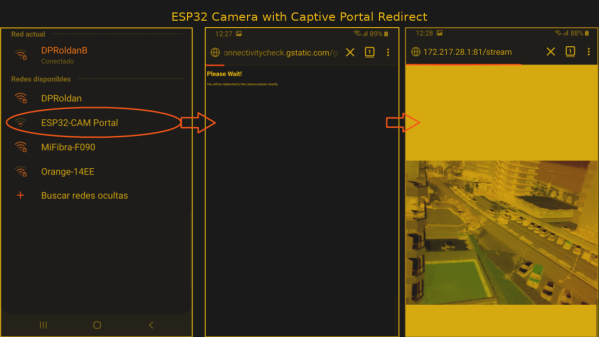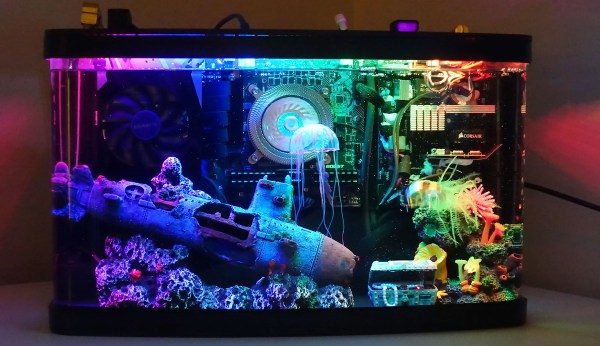The power grid is a complicated beast, regardless of where you live. Power plants have to send energy to all of their clients at a constant frequency and voltage (regardless of the demand at any one time), and to do that they need a wide array of equipment. From transformers and voltage regulators to line reactors and capacitors, breakers and fuses, and solid-state and specialized mechanical relays, almost every branch of engineering can be found in the power grid. Of course, we shouldn’t leave out the most obvious part of the grid: the wires that actually form the grid itself.
Smarten Up Your Air Conditioning With The ESP8266
If you’re looking for “smart” home appliances, there’s no shortage of options on the market. Even relatively low-end gadgets are jumping on the Internet of Things bandwagon these days (for better or for worse). But what if you’re not looking to purchase a brand new major appliance right now? In that case, you might be interested in seeing how [Giulio Pons] added some high-tech features to his existing air conditioner on the cheap.
Since his AC unit had an infrared remote control, the first thing [Giulio] needed to do was come up with a way to emulate it. An easy enough project using the ESP8266 and an IR LED, especially when he found that somebody had already written a IR communications library for his particular brand of AC. From there, he could start tacking on sensors and functionality.
 With the addition of a DHT11 sensor, [Giulio] can have the AC turn on and off based on the current room temperature. It also gives him an easy way to verify the AC is actually on and operating. By checking to see if the room starts cooling off after sending the IR command to start the AC, his software can determine whether it should try resending the code, or maybe send a notification to alert him that something doesn’t seem right. Of course, it wouldn’t be a proper ESP8266 project without some Internet connectivity, so he’s also created a smartphone application that lets him control the system while away from home.
With the addition of a DHT11 sensor, [Giulio] can have the AC turn on and off based on the current room temperature. It also gives him an easy way to verify the AC is actually on and operating. By checking to see if the room starts cooling off after sending the IR command to start the AC, his software can determine whether it should try resending the code, or maybe send a notification to alert him that something doesn’t seem right. Of course, it wouldn’t be a proper ESP8266 project without some Internet connectivity, so he’s also created a smartphone application that lets him control the system while away from home.
Now admittedly nothing in this project is exactly new, we’ve seen plenty of hackers switch on their AC with the ESP8266 at this point. But what we particularly liked was how well thought out and documented the whole process was. The rationale behind each decision is explained, and he even documented things like his network topology to help illustrate how the whole system comes together. Even if the techniques are well known by many of us, this is the kind of project documentation that makes it accessible to newcomers. Our hats off to [Giulio] for going the extra mile.
In the past we’ve seen a similar project that allowed you to control your AC from Slack, and our very own [Maya Posch] took us on a whirlwind tour of the very impressive ESP8266-powered environmental monitoring system she helped develop.
Vintage Speech Synthesizer Croons The Oldies
If you listened to the National Weather Service Weather Radio in the US about 25 years ago, you’ll no doubt remember [Perfect Paul], one of the synthesized voices used to read current conditions and weather forecasts. The voice came from a DECtalk DTC01, a not inexpensive voice synthesizer first made in 1984 that also gave voice to [Stephen Hawking] for many years.
Long obsolete, the DECtalk boxes have a devoted following with hobbyists who like to stretch what the device can do. Some even like to make it sing, after a fashion, and [Michael] decided that making a DECtalk sing “Xanadu”, the theme song from the 1980 [Olivia Newton-John] musical extravaganza, was a good idea. Whether it actually was is debatable, and we’ll take exception with having that particular ditty stuck in our head as a result, but we don’t judge except on the merits of the hack.
It’s actually easy if you have a DECtalk; the song is a straight ASCII file with remarkably concise instructions on which phonemes the box needs to generate. Along with inflection, tone, and timing instructions, the text file looks almost completely unlike English while still somehow being readable. The DECtalk accepts the file over RS-232, which would be easy enough to do with a modern computer, but [Michael] upped his game a bit by using a TRS-80 Model 100 computer as a serial terminal. The synthesized song is in the video below, with the original included for reference by those who didn’t experience endure the late disco-era glory days.
DECtalks seem pretty rare in the wild, so we appreciate this glimpse at what they can do. There are other retro speech synthesizer hacks, though: the simulated walnut goodness of the Votrax and the MicroVox come to mind, as does the venerable TI Speak and Spell.
Continue reading “Vintage Speech Synthesizer Croons The Oldies”
Captivating ESP32 Camera Hack
You can never have enough DIY devices at home, so when you look at an ESP32 module that comes with the camera, you automatically start getting ideas. [Daniel Padilla] wanted a way to deploy DIY camera modules without the hassle of configuring them so he made one that looks like an access point and starts streaming as soon as you connect to it.[GitHub]
The code he provides allows the ESP32 to appear as an Open Access Point which you can connect to from a PC or smartphone. The awesome sauce here is that the ESP32 resolves all DNS requests to a redirect in a similar manner to what happens when someone connects to an open Wi-Fi access point in a mall, Instead of a captive portal page that asks the user to authenticate or accept terms and conditions, [Daniel Padilla]’s code instead redirects to the streaming page et voila! Instant camera stream, and it is that simple.
We love this project because it is an elegant way to solve a problem, and it also teaches newbies about captive portals and their implementation. We covered a cheap ESP32 Webcam in the past and this project also comes with code for you to get started. We would love to see what you come up with next.
Schrodinger’s Cat Lives
If quantum physics always sounded a little squirrelly to you, take heart. Yale researchers have announced that they can do what quantum physics claimed to be impossible: they can determine the state a quantum system will collapse to before it happens. This contradicts Schrodinger’s famous hypothetical cat that is superimposed as 50% alive and 50% dead at the same time. The research appears in Nature.
Schrodinger argued that until you open the box, the cat is half alive and half dead in the same way that a qubit can be in 50% of one state or another. When you observe it, you force the system to one state. Researchers at Yale, however, have found a way to use microwaves to indirectly monitor qubits to determine their state prior to the system making a jump. Unlike a normal observation which occurs too late, the Yale technique allows researchers to change the future state to their choice.
Something’s Fishy About This Computer
Aquariums are amazingly beautiful displays of vibrant ocean life, or at least they can be. For a lot of people aquariums become frustrating chemistry battle to keep the ecosystem heathly and avoid a scummy cesspool where no fish want to be.
This hack sidesteps that problem, pulling off some of the most beautiful parts of a living aquarium, while keeping your gaming rig running nice and cool. That’s right, this tank is a cold mineral oil dip for a custom PC build.
It’s the second iteration [Frank Zhao] has built, with many improvements along the way. The first aquarium computer was shoe-horned inside of a very tiny aquarium — think the kind for Beta fish. It eventually developed a small crack that spread to a bigger one with a lot of mineral oil to clean up. Yuck. The new machine has a much larger tank and laser cut parts which is a step up from the hand-cut acrylic of the first version. This makes for a very nice top bezel that hangs the PC guts and provides unobtrusive input and output ports for the oil circulation. A radiator unit hidden out of sight cools the oil as it circulates through the system.
These are all nice improvements, but it’s the aesthetic of the tank itself that really make this one special. The first version was so cramped that a couple of sad plastic plants were the only decoration. But now the tank has the whole package, with coral, more realistic plants, a sunken submarine, and of course the treasure chest bubbler. Well done [Frank]!
Adding Bluetooth Control To A Benchtop Power Supply
In 2019, it’s possible to kit out a lab with all the essentials at an even cheaper price than it has ever been. The DPS3005 is one such example of low-cost equipment – a variable power supply available for less than $50 with a good set of features. [Markel Robregado] wanted a little more functionality, however, and got down to work.
The crux of [Markel]’s project is improved connectivity. A Texas Instruments CC2640R2F Launchpad is employed to run the show, with its Bluetooth Low Energy capability coming in handy. A custom smartphone app communicates with the Launchpad, which then communicates with the power supply over its Serial Modbus interface. Through the app, [Markel] can set the voltage and current limit on the power supply, as well as switch it on and off. This could prove useful, particularly for remote triggering in the case of working with dangerous projects. Sometimes it pays to take cover, after all.
We’ve seen power supplies modified before; this pot mod for higher precision is a particular treat. If you’ve hacked your bench hardware for better performance, let us know. Video after the break.
Continue reading “Adding Bluetooth Control To A Benchtop Power Supply”

















